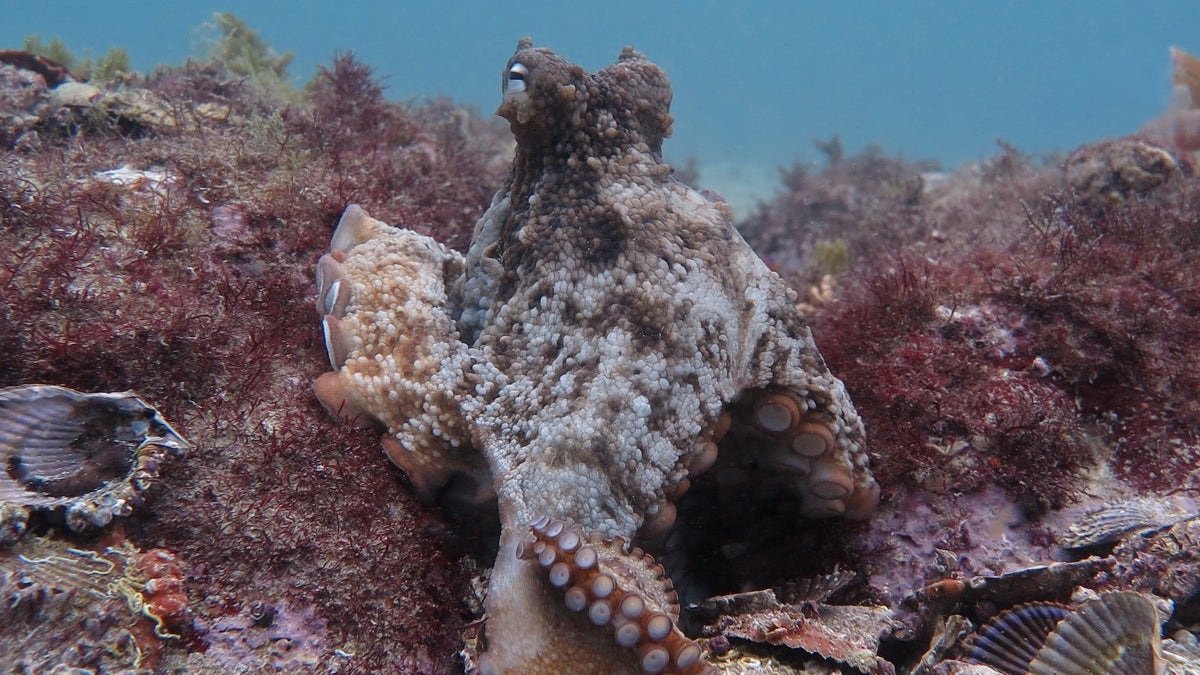
A gloomy octopus (<em>Octopus tetricus</em>) in Jervis Bay, Australia. (Peter-Godfrey Smith)
In the briny waters of Jervis Bay on Australia's east coast, where three rocky outcrops jut out from piles of broken scallop shells, beer bottles and lead fishing lures, a clutch of octopuses gambol among a warren of nearly two dozen dens. Welcome to Octlantis.
The bustling community belies conventionally held notions of the cephalopods, once thought to be solitary and asocial.
Indeed, Octopus tetricus, known colloquially as the gloomy octopus, has always been framed as a bit of a loner, with males and females meeting only once a year to mate. [See Photos of the Gloomy Octopuses Interacting at Octlantis]
Even then, there's barely any touching. To avoid being throttled and eaten by a hungry female, the male octopus uses a specialized arm to jettison packets of sperm called spermatophores into the giant bulb behind the female's head, also known as the mantle.
In the site they have christened "Octlantis," however, an international team of marine biologists, led by Alaska Pacific University's David Scheel, observed "complex social interactions" among 10 to 15 octopuses on eight different days, as they foraged, mated and fought in close quarters.
Their research, published online Sept. 1 in the journal Marine and Freshwater Behaviour and Physiology, reveals an animal that is far from reclusive. In hours of footage recorded using four GoPro cameras, the octopuses are seen exhibiting threat displays and other signs of aggression, including violently ejecting one another from their dens.
Faced with a would-be adversary, an octopus might darken its mantle to express its disgruntlement or splay itself lengthwise to appear larger. When going mano a mano — or tentacle to tentacle — one octopus might whip out its suckered arm to flail at another.
It's a behavior that Stephanie Chancellor, a graduate student in biological sciences at the University of Illinois at Chicago and an author on the paper, said she found surprising.
"I know these animals are intelligent, but this behavior — the communication, the grappling, all of them together — is very sophisticated," she told Live Science. "And it's pretty much unheard of with invertebrates."
As a community, Octlantis isn't unprecedented. In 2009, citizen scientist Matthew Lawrence and the University of Sydney's Peter Godfrey-Smith, both co-authors of the current paper, discovered a similar settlement a few hundred yards away. Dubbed "Octopolis," it housed several dens and featured one key difference: an unidentified metal object about 12 inches (30 centimeters) long, likely "garbage from a boat," Chancellor said.
At the time, scientists thought that the settlement had formed as a result of the artificial object. But then Octlantis came along, with no similar item in place.
"We were thinking this congregation of octopuses could only happen with human influence," Chancellor said. "Since nothing human seeded Octlantis, it turns out that it can happen naturally under the right conditions." [8 Crazy Facts About Octopuses]
Premeditated? Not exactly
As tempting as it is to read human motivation into animal behaviors, Octlantis isn't the premeditated community we might perceive it to be. To put it bluntly, urban planners these octopuses are not.
"We definitely don't think they have any intention of creating the site," Chancellor said. "I think it's just an outcome of their denning behavior."
Octopuses are "mostly opportunists," she said. "If they do find a spot that looks good, they will excavate it a little bit, or they will dig it out a little bit, but they won't find a spot and plan to den there. It already has to be a relatively good spot for them to live."
They're pretty savvy engineers, too. When they're not squabbling, the cephalopods amass discarded shells, along with scavenged trash like beer bottles and lead fishing lures, in order to better stabilize the sediment for excavating dens.
Still, Chancellor could only speculate why the octopuses have decided to stick together, considering that they appear to be reluctant neighbors at best.
"I think there's something about Jervis Bay that is beneficial enough for them to live together and have to put up with one another," she said. "We really don't know what's going on exactly, but it's most likely because they're den-limited, so they don't really have any other choices than to live together."
Or perhaps the female octopuses established dens in the area first, and then the males followed suit to improve their mating options.
"That's something I'm trying to figure out as one of my goals," Chancellor said.
More questions than answers
Ultimately, Octlantis raises more questions than it answers. Have the octopuses there laid down permanent roots, or are they transient residents? Is there a social hierarchy? Are the octopuses being territorial, or are they hoarding mates? [From Blobfish to 'Adorable' Octopus: 9 Animals with Perfect Names]
"That's something we don't know, since it's really hard to tell octopuses apart from one another; they don't really have any distinguishing marks on them, and their size can differ greatly based on their posture," Chancellor said. "That's one of the difficulties we're having: If an octopus leaves a site, are we able to tell if it's the same octopus returning?"
The obvious solution would be to tag the animals — a task that would require a great deal more effort, not to mention additional funding, to pull off.
"It would be amazing to look at how they move around Jervis Bay, if they move between sites, or if they just stay within the same home range," she said.
Chancellor said she also wants to know whether a teeming population of octopuses attracts more predators, such as sharks, dolphins or seals, or if there's greater safety in numbers.
"They're so bizarre compared with other animals that we know of," she said. "For me, they're like the closest I can get to working with an alien."
Original article on Live Science.
